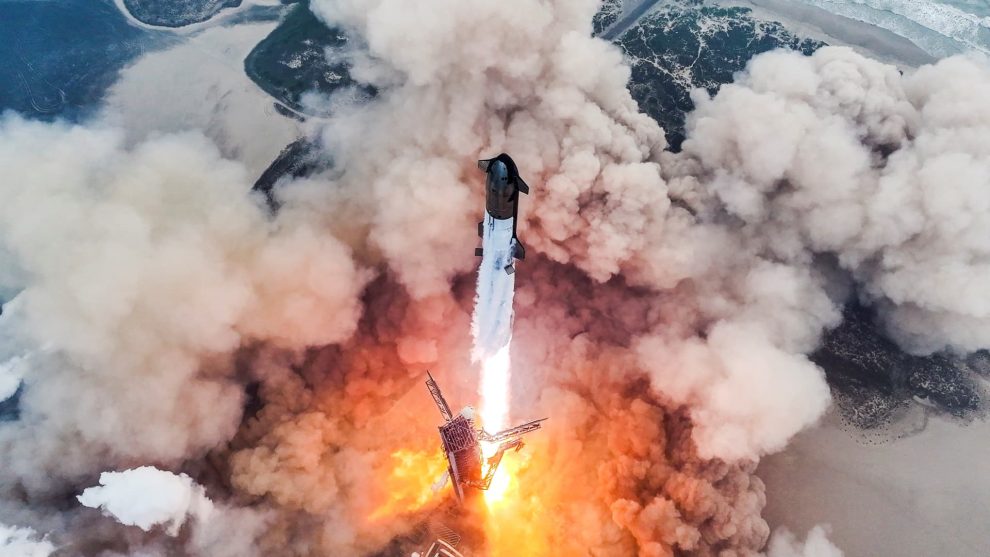SpaceX has unveiled its ambitious plan to catch the upper stage of its massive Starship rocket using a pair of mechanical arms dubbed “chopsticks.” This revolutionary approach to rocket recovery promises to redefine the economics of space travel and push the boundaries of what’s possible in aerospace engineering.
SpaceX, the trailblazing company founded by tech mogul Elon Musk, has long been at the forefront of reusable rocket technology. Their Falcon 9 boosters, which land propulsively on drone ships or land-based pads, have become a common sight in the space industry. However, the company’s plans for Starship—its next-generation, fully reusable spacecraft designed for missions to the Moon, Mars, and beyond—take the concept of rocket reusability to an entirely new level.
We’re not just iterating on existing technology; we’re completely reimagining how we approach spacecraft recovery,” said Gwynne Shotwell, President and COO of SpaceX. The ‘chopstick’ catch mechanism represents a paradigm shift in how we think about bringing spacecraft back to Earth.
The Chopstick Catch: How It Works
The “chopstick” catch mechanism is part of the launch and catch tower, affectionately nicknamed “Mechazilla” by SpaceX enthusiasts. This massive structure, standing over 400 feet tall, is equipped with two enormous mechanical arms designed to catch the Starship upper stage as it descends back to Earth.
Here’s how the audacious maneuver is expected to work:
- As the Starship upper stage reenters the atmosphere, it will use a combination of aerodynamic surfaces and thrusters to guide itself towards the launch site.
- The spacecraft will perform a “belly flop” maneuver, falling horizontally to maximize drag and slow its descent.
- In the final moments before landing, Starship will ignite its engines and flip vertical, much like the current Starship prototype landings.
- Instead of landing on its own legs, Starship will carefully position itself between the two mechanical arms of the launch tower.
- The arms, moving with precision, will close around Starship, catching it by its protruding fins or “wings.”
- Once secure, the arms will gently lower Starship onto the launch mount, ready for inspection and rapid reuse.
Dr. Emily Chen, an aerospace engineer not affiliated with SpaceX, explained the potential benefits of this approach: “By catching Starship, SpaceX eliminates the need for heavy landing legs, which translates to more payload capacity. It also allows for immediate positioning of the vehicle for refueling and relaunch, potentially reducing turnaround time dramatically.”
Engineering Challenges and Innovations
The “chopstick” catch mechanism presents a host of engineering challenges that SpaceX must overcome:
Precision and Timing
Catching a massive spacecraft traveling at high speeds requires unprecedented precision. SpaceX is developing advanced guidance systems and control algorithms to ensure that Starship can position itself accurately for the catch.
“The level of precision required is staggering,” said Dr. Alex Patel, a control systems expert. “We’re talking about aligning a 50-meter tall vehicle within centimeters of its intended position, all while it’s descending at significant speeds. It’s like threading a needle, except the needle is the size of a skyscraper.
Structural Integrity
The arms of the catch mechanism must be strong enough to withstand the forces involved in catching Starship without damaging the vehicle.
“The structural engineering involved is fascinating,” commented Dr. Sarah Thompson, a materials scientist. “The arms need to be incredibly strong yet also capable of absorbing and dissipating the energy of the catch without causing stress to Starship’s structure.”
Weather Considerations
Wind and other weather conditions could significantly impact the success of the catch. SpaceX is developing advanced weather monitoring and predictive systems to ensure safe operations.
Implications for Space Travel
If successful, the “chopstick” catch mechanism could have far-reaching implications for the future of space travel:
Rapid Reusability
By eliminating the need for landing legs and enabling immediate repositioning for refueling, the catch system could dramatically reduce the turnaround time between Starship flights.
“This system has the potential to enable a launch cadence we’ve never seen before in spaceflight,” said Marco Cáceres, a senior space analyst at the Teal Group. We could be looking at multiple Starship launches per day from a single pad.
Increased Payload Capacity
Without the weight of landing legs, Starship could carry more payload to orbit, to the Moon, or to Mars.
“Every kilogram saved on the vehicle itself is a kilogram that can be used for payload,” explained Dr. Chen. “This could significantly increase the efficiency of cargo missions to the Moon or Mars.”
Cost Reduction
Rapid reusability and increased payload capacity could further drive down the cost of access to space, opening up new possibilities for space exploration and commercialization.
“If SpaceX can make this work, it could reduce launch costs by an order of magnitude,” said Cáceres. This would have profound implications for everything from satellite deployment to space tourism.
Skepticism and Concerns
While many in the space community are excited about the potential of the “chopstick” catch system, some experts have expressed skepticism about its feasibility and safety.
Dr. Jane Foster, a former NASA engineer, voiced her concerns: “The margins for error are incredibly slim. Any miscalculation could result in the loss of a billion-dollar spacecraft and potentially endanger ground personnel.”
Others have questioned whether the complexity of the system might actually increase turnaround times and maintenance requirements compared to traditional landing methods.
SpaceX has acknowledged the challenges but remains confident in its approach. We understand the risks and complexities involved,” said Shotwell. But we also believe that pushing the boundaries of what’s possible is essential for advancing spaceflight technology.
Testing and Development Timeline
SpaceX has already begun testing components of the catch system at its Starbase facility in Boca Chica, Texas. The company has conducted several tests of the arm mechanisms, moving massive weights to simulate the catching process.
While SpaceX has not announced a firm timeline for the first catch attempt, industry insiders speculate that we could see a test as early as next year.
“Knowing SpaceX’s rapid development cycle, I wouldn’t be surprised if we see a catch attempt within the next 12 to 18 months,” said Casey Dreier, Chief Advocate and Senior Space Policy Adviser at The Planetary Society.
As SpaceX continues to develop and refine its “chopstick” catch system, the space industry and enthusiasts around the world are watching with bated breath. The success or failure of this audacious plan could shape the future of space exploration for decades to come.
“What SpaceX is attempting here is nothing short of revolutionary,” said Dr. Ellen Stofan, former Chief Scientist at NASA. If they succeed, it will be a testament to human ingenuity and our capacity to reimagine what’s possible in spaceflight.
SpaceX’s plan to catch Starship with mechanical “chopsticks” represents one of the most ambitious and innovative approaches to spacecraft recovery ever attempted. It embodies the company’s ethos of pushing the boundaries of aerospace engineering and rethinking conventional wisdom about how we access space.
As we stand on the brink of a new era in space exploration, with plans for lunar bases and Martian colonies on the horizon, innovations like the “chopstick” catch mechanism may prove crucial in making these dreams a reality. While significant challenges remain, the potential rewards—in terms of reusability, efficiency, and cost reduction—are equally enormous.
Whether SpaceX succeeds in its audacious plan or not, the very attempt is pushing the entire space industry to think bigger and bolder about the future of spaceflight. As we watch this cosmic ballet unfold, one thing is certain: the race to revolutionize space travel is far from over, and SpaceX’s cosmic chopsticks may just be the next giant leap for mankind.
















Add Comment